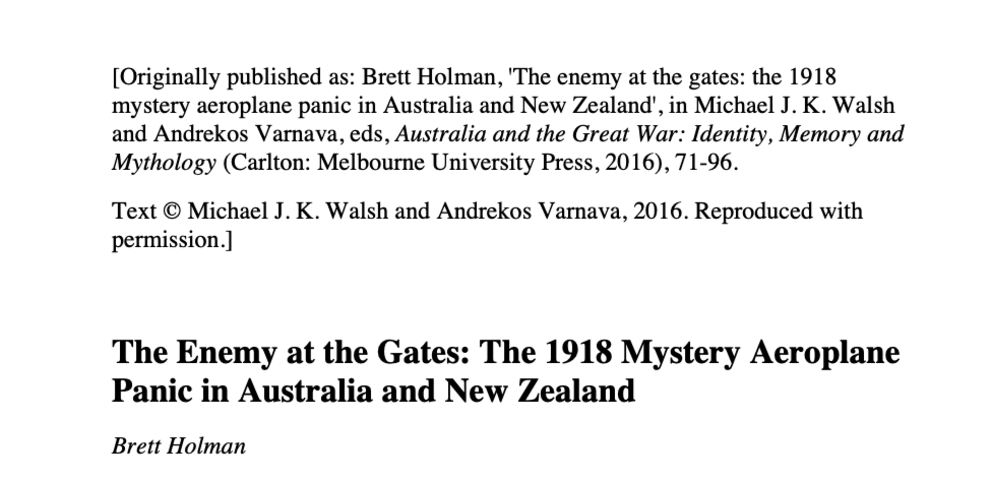The 1918 ‘mystery aeroplane panic’ in Australia and New Zealand
'The enemy at the gates: the 1918 mystery aeroplane panic in Australia and New Zealand'
Originally published as: Brett Holman, ‘The enemy at the gates: the 1918 mystery aeroplane panic in Australia and New Zealand’, in Michael J. K. Walsh and Andrekos Varnava, eds, Australia and the Great War: Identity, Memory and Mythology (Carlton: Melbourne University Press, 2016), 71-96. Available from Melbourne University Press. Details here. PDF format.
Text © Michael J. K. Walsh and Andrekos Varnava, 2016. Reproduced with permission.
First paragraph: Objectively, Germany posed little direct threat to Australia and New Zealand during the Great War: it was, after all, on the opposite side of the planet. Subjectively, however, it was a different matter. In the public imagination, the two dominions were saturated with German spies, who were passing information back to the Fatherland, carrying out acts of sabotage and subverting the loyalty of ‘British’ Australians and New Zealanders through pacifist and socialist propaganda. This fear of the ‘enemy within the gates’, in historian Ernest Scott’s phrase, is well known. But the fear of the enemy at the gates, the fear of external attack, is not. While the spectre of a German invasion and occupation was frequently employed for propaganda purposes in both Australia and New Zealand during the war, it is not clear how many people saw this as a realistic threat. Perhaps surprisingly, though, at least by the last year of the war, the main danger was perceived to come not on land or from the sea—at least not directly— but from the air. The little-known mystery aeroplane panic of 1918 is the most extreme example of this fear. The hundreds of reports received by the press and the authorities in Australia and, to a lesser extent, New Zealand, of otherwise unexplainable aircraft flying over widely separated parts of both countries were widely interpreted as being German in origin, operating from naval raiders off the coast or from secret bases inland. The reports were spurious, misperceptions or hoaxes, but both governments took them seriously; Australia, at least, undertook substantial defensive precautions as a result, turning what otherwise would have been a minor scare into a major panic.

